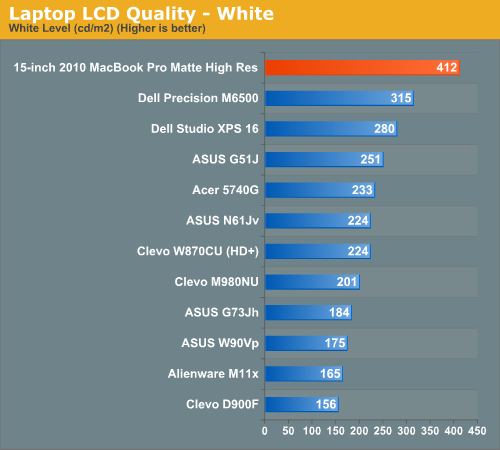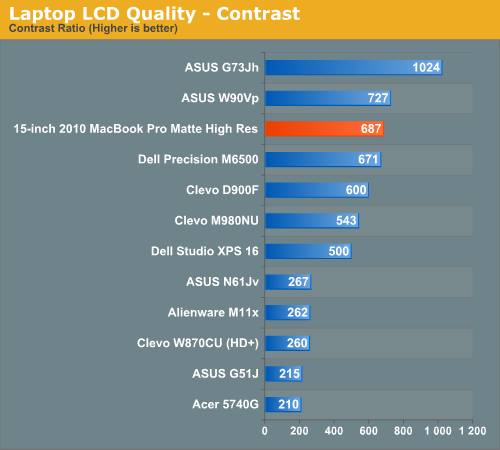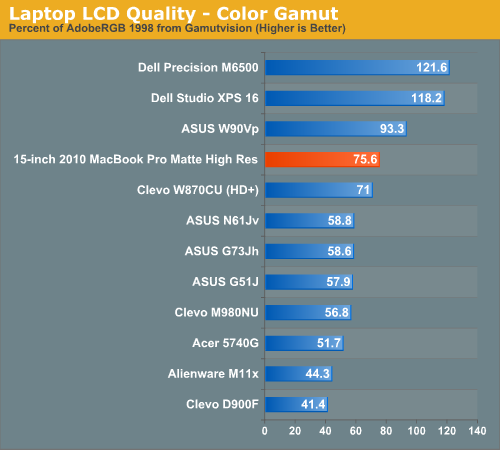Apple's 15-inch 2010 MacBook Pro: More Battery Life Tests, High Res Display Evaluated
by Anand Lal Shimpi on April 24, 2010 1:57 AM EST- Posted in
- Mac
- Displays
- MacBook Pro
- Arrandale
- Laptops
High Resolution, Matte Display: Tested
For creative professionals and digital photography or videography enthusiasts alike, LCD quality of the MacBook Pro is a huge consideration. Luckily, Apple delivers in this department.
Apple thankfully provides matte high resolution display options for both the 15” and 17” MacBook Pros. If you’re partial to glossy displays, there’s also a glossy high resolution display option available online, though it isn’t one of the SKUs that will be stocked in Apple retail stores - you’ll have to order it online.
Since many creative professionals likely will seek the matte option (and because it’s the only high resolution display option available in-store), we chose to do monitor profiling and analysis with this particular model. On the surface, very little has changed, the display itself still substitutes the black glass bezel for an aluminum one. The LCD sits inset from the aluminum bezel about a millimeter, diminishing the chances of your keyboard smudging and scratching up the display like what was so endemic with the pre-unibody design.
| 15-inch 2010 MacBook Pro 6,2 Core i7 | |||
|
Matte High Resolution Display Option
|
|||
| Panel Type | TN (Samsung LTN154MT07) | ||
| Pixel Pitch | 0.197mm | ||
| Viewable Size | 15.4 diagonal | ||
| Resolution | 1680 x 1050 (WSXGA+) | ||
| Screen Treatment | Matte (anti-glare) | ||
The first thing that strikes you about the 2010 MacBook Pro LCD is how bright it is. As we’ll show in a minute, it’s the brightest LCD we’ve tested, thanks in part to its WLED backlighting. While the color gamut is only above average, Delta E tracking is also very good.
For these tests, we used ColorEyes Display Pro with an X-Rite Eye-One Display 2 colorimeter. I originally tested at maximum brightness, and then at precisely 200 nits of luminance. The black level down below is given at maximum brightness. Interestingly enough, Delta E tracking and color accuracy remains largely the same at both settings.
Another note I’ll leave you with is that although using a calibration tool is still an absolute must for the best monitor performance, Apple’s display profile that ships with OS X is surprisingly good. Out of box, the display’s white point was almost exactly 6500K, and the LUT curves subjectively nearly matched those that eventually resulted after calibration. Color tracking and Delta E weren’t good, but subjectively the display looked good.





The LED backlight Apple uses in the display still isn’t RGB LED, so color gamut isn’t anything spectacular, but it isn’t bad either. Performance is average, but what we get is both expected and pretty good for this class of LED backlit notebook displays.


Display uniformity is very good; there is virtually no distracting light leakage from any of the displays. In addition, black level is very good throughout. The viewing angles remain largely what you’d expect from any TN panel in its class. There isn’t an overwhelming amount of color shift when viewing the monitor at horizontal angles. Vertical is another story - there’s a tight range of vertical angles over which the color shift is negligible.
The performance we get with the MacBook Pro’s display is very good - but it still could be better. Among WLED backlit, TN packing notebook LCDs, it certainly shines out as one of the best options. That said, there’s no reason this “Pro” notebook shouldn’t see RGB LED backlighting and potentially even an IPS panel as options soon. Enthusiasts and professionals are more than willing to shell out the cash for large gamut LCDs on the desktop - why not on the notebook? It’s obvious that Apple isn’t averse to IPS panels, especially considering the iPad.
















69 Comments
View All Comments
Penti - Sunday, April 25, 2010 - link
There is still no IPS-panels for notebooks being produced really even though the battery powered iPad got one in a area where there were none, but on the other hand as they try to sell it as a machine that can do anything they need a wide-angle viewing screen. Otherwise people would just laugh at it as a ebook-reader and cool colors and comics won't change that. People have grown used to sitting straight in front of the laptop screen. It just isn't acceptable in a tablet device, and smart phones has even begun using AMOLED screens. In fact the professional tablets (i.e. those costing 1500+ dollars) have been using IPS based screens for a while now. But I don't think a single screen is manufactured for 15" notebooks with IPS, and the screens for the 12-13" convertible tablets are optimized for power consumption and viewing angles any way not color. I don't see Apple pony up for IPS-panels in the macbooks. They will get them when the others do use them. Custom parts just aren't apart of their computer lineup. We can't expect more then the Geforce 320M chipset in that apartment :)rcocchiararo - Sunday, April 25, 2010 - link
Are there diferent "grades" in TN panels quality ?im 100% sure my GF notebook has worse viewing angles than my late 2008 macbook pro, and that my 2007 or so macbook white was similar or worse than my gf notebook.
Also, no notebook from work has a decent display either.
I almost thought that my macbook pro had a "mobile version" of the s-ips panel my 20.1 inches dell from 2007 has :P
rpottol - Tuesday, April 27, 2010 - link
Yup, Levanto dropped them from Thinkpads because the just could not get them reliably in the quantities they needed.Sigh.
I think I will stick with older thinkpads, but then I'm the sort of person who would want a 15" QXGA display (2048x1536) and yet not have the CPU for HD playback (well, perhaps).
Xyp - Monday, April 26, 2010 - link
Anand -There is lots of interest in seeing some of your benchmark numbers on the current-gen MBPs (128, 256, and 512...), especially after degradation. If any of your people know the skinny on whether Apple has at all revised the firmware on the currently-shipping Toshiba drives, or whether they will be attempting a TRIM-like function (let's be serious, it's Apple... they'll rename it) with updates to OSX, that information would also be much appreciated.
Thanks for your excellent site.
Wolfpup - Monday, April 26, 2010 - link
Does this let you install the normal Nvidia reference drivers under Windows? People seem to think Apple's preventing it (or possibly it won't work because of their switching technology).Either way, if this won't run normal drivers, that rules it out for me :(
asiafish - Monday, April 26, 2010 - link
I just got the new 15" i7 with high-res matte display, and must say this is by far the fastest computer I have ever owned. Build-quality is every bit as good as my Oct 08 MacBook Air, and far better than any pre-unibody Mac (or any other laptop) I've ever used.Battery life is incredible with simple browsing in Safari and email/calendar in Entourage.
gochichi - Tuesday, April 27, 2010 - link
For example, does the glossy high resolution screen offer up the same backlight? How do you know that the $50 cheaper glossy display will have the 400 nits backlight? Is the 1440x900 screen as bright?I mean guys, what I'm hoping a tech website can do for me just to put it bluntly is help me make a decision as to which product to use or buy. In a nutshell, help me make an informed decision. What I want to see is a 3-way comparison of the standard glass covered display, the glossy high res display and the matte high res display. What I get instead is an opinion that someone else would go with a glossy high res display that they've in fact never even seen.
Measure stuff for me, show me some pictures of things I want to see. I've been a long term reader of Anandtech and frankly I expect the obvious. Worse yet, I can go to a local Apple shop and compare th low res to the matte display for myself.
Honestly... on what grounds are you recommending the glossy high res. It just "sounds cool"? Sigh.
Brian Klug - Friday, May 14, 2010 - link
I think you're reading a different article entirely, because basically everything you just sounded off on is actually in this one:1. 400 nits claim - Right inside: http://www.anandtech.com/show/3669/apples-15inch-2...
Performance was 412 measured with an i1D2.
2. Matte > Glossy - Also inside: http://www.anandtech.com/show/3669/apples-15inch-2...
Comparison and side-by-side with photos.
I'm confused what you're reading, because *all* of that stuff is there.
-Brian
jlyall - Saturday, May 1, 2010 - link
Hi Anand,A big cheers for both the write ups on the new MBP. You have made my job of choosing about 1000x times easier. The hole in my pocket will be bigger but I know I will be happier in the long run. Cheers again and have a lovely day.
warmest regards,
J
Woodoo - Tuesday, May 4, 2010 - link
Hi there, I have a question regarding viewing angles differences between the glossy and matte options. Is there a noticable (or at least some) difference between the two LCD panels mounted to the latest MacBook Pros in this aspect?P.S.: I'd love to see an IPS panel in the future MacBooks Pro, even as a high price option...